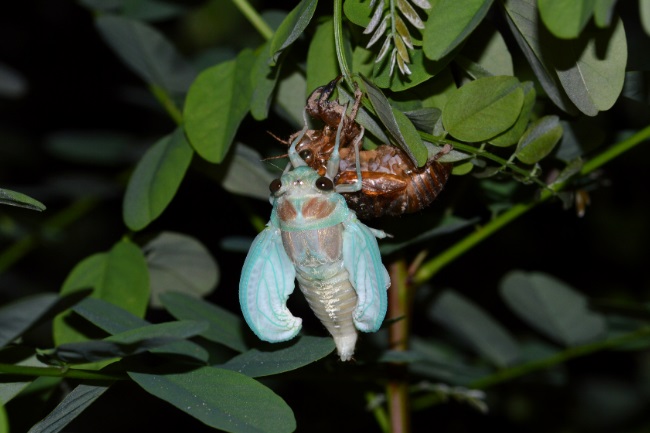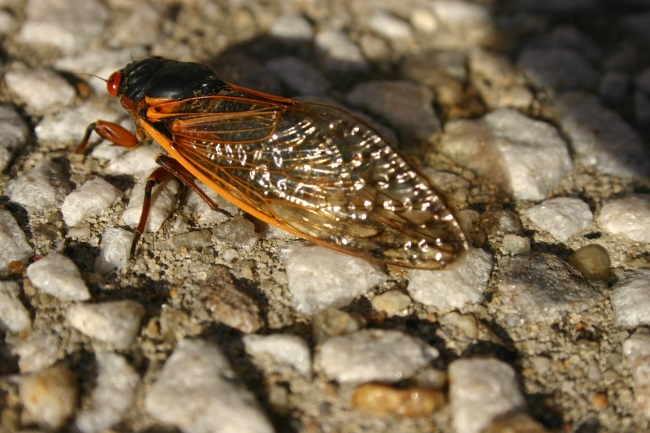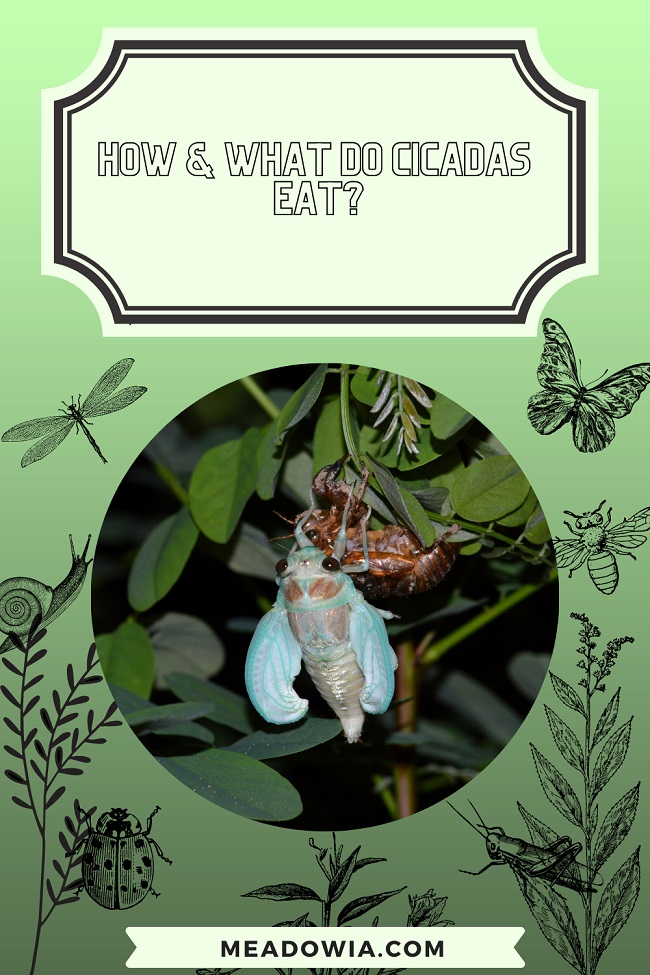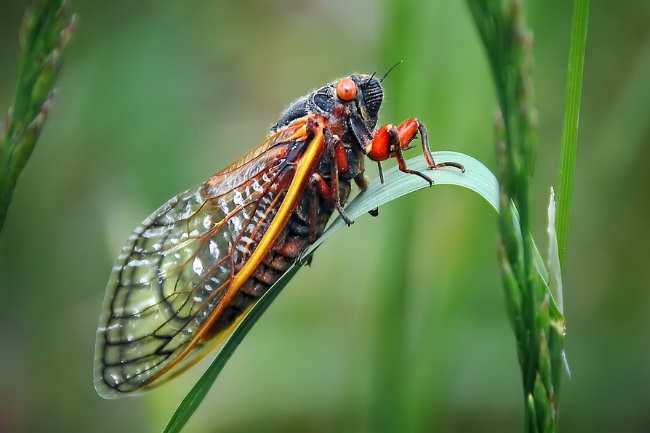Cicadas, facts and photos
Cicadas are members of the superfamily Cicadoidea and are physically distinguished by their stout bodies, broad heads, clear-membraned wings, and large compound eyes.
There are more than 3,000 species of cicadas, which fall into roughly two categories: annual cicadas, which are spotted every year, and periodical cicadas, which spend most of their lives underground and only emerge once every decade or two.
Cicadas are famous for their penchant for disappearing entirely for many years, only to reappear in force at a regular interval. Despite their name, annual cicadas generally live for two to five years—though some species may live longer—and their brood life cycles overlap, meaning that every summer, some cicadas emerge. Even periodical cicadas occur most years in different geographic regions as they are split among 15 brood cycles, each lasting 13 or 17 years.
The cicadas’ amazing lifestyle has been a source of fascination since ancient times. Several cultures regarded these insects as powerful symbols of rebirth due to their unusual life cycles. In early Chinese folklore, cicadas were also considered high-status creatures that rulers should seek to emulate in their purity, and cicada motifs even became incorporated into imperial court wardrobes in the seventh century.
Geographic range
While annual cicadas can be found throughout the world, periodicals are unique to North America. Periodical broods are concentrated in the central and eastern regions of the United States, and some areas are home to multiple broods.
The cicada life cycle has three stages: eggs, nymphs, and adults. Female cicadas can lay up to 400 eggs divided among dozens of sites—generally in twigs and branches. After six to 10 weeks, young cicada nymphs hatch from their eggs and dig themselves into the ground to suck the liquids of plant roots. They spend their entire developmental period in these underground burrows before molting their shells and surfacing as adults to mate and lay eggs.
The developmental process varies in length, but periodical broods emerge in synchrony depending on the year and soil temperature. They wait for the right conditions for breeding, which are when the ground thaws to 65°F (18°C) in a brood’s designated year. It’s not clear why these cicadas have such distinct and oddly timed cycles, though some scientists theorize it has to do with avoiding predators.
Periodical cicadas do not create destructive plagues, as some locusts do, though as many as 1.5 million cicadas may crowd into a single acre. Unlike locusts, cicadas don’t eat vegetation but rather drink the sap from tree roots, twigs, and branches. Large swarms can overwhelm and damage young trees by feeding and laying eggs in them, but older trees usually escape without serious damage as cicadas don’t stick around for long. Adults die off within about four to six weeks after emerging.
Cicadas: Facts about the loud, seasonal insects
Cicadas are responsible for nature’s summer soundtrack in much of the U.S.

A periodical cicada from Brood XIII, which emerged in 2007, sits on a fence at a forest preserve in Willow Springs, Illinois. (Image credit: Scott Olson/Getty Images)
- What do cicadas look like?
- How do cicadas reproduce?
- What are cicadas’ habits?
- What do cicadas eat?
- Are cicadas endangered?
- Other cicada facts
- Additional resources
Cicadas are winged insects that produce a loud buzzing song that can be heard throughout the summer, and they live on every continent except Antarctica. Annual cicadas appear each year in late June through August. Periodical cicadas, found only in parts of North America, emerge from late April through early May in a cycle that spans 13 or 17 years, depending on the species.
What do cicadas look like?
There are around 3,400 cicada species, of which seven are periodical cicadas (three 17-year cicada species and four 13-year cicada species), according to Scientific American. All cicadas have large, bulging eyes; these are usually black or green in annual cicadas, and are typically bright red in periodical cicadas (but in rare cases, periodical cicada eyes can be white, blue, yellow, or even multicolored, according to Cicada Mania).
Annual cicadas’ bodies can be solid or patterned in shades of black, brown and green, and they measure about 1.75 inches (44 millimeters) long on average, according to North Carolina State University in Raleigh. Periodical cicadas’ bodies are deep black and are a bit smaller than those of annual cicadas’, measuring about 0.75 to 1.25 inches (19 to 32 mm) long. Cicadas’ wings are veined and transparent, and darker veins near the tips of the wings in some species make the shape of a “W.” They have no stingers and lack chewing mouthparts, so they can’t bite. Adult females have a sharp ovipositor, a styluslike organ for egg laying, and males have ribbed tymbals — exoskeleton structures of alternating stiff and flexible membranes — on the first abdominal segment. When males rapidly expand and contract their tymbals, the vibration produces the cicada’s distinctive summer song.
Kingdom: Animalia
Phylum: Arthropoda
Class: Insecta
Order: Hemiptera
Family: Cicadidae
As juveniles, or nymphs, cicadas are white and resemble ants or termites. They grow underground by molting through several nymph stages called instars. During the last instar stage, nymphs emerge from their burrows. This aboveground nymph stage is wingless with a light-brown exoskeleton and large front limbs that it uses to anchor itself to trees, plants or tall grasses, in preparation for the final molt — into its adult form.
When adults break out of the nymph exoskeleton their bodies are soft and white, but over the next few hours their wings unfurl and their adult exoskeleton hardens and darkens — they are known as teneral adults during this transitional phase, while their bodies are still soft, according to the University of Connecticut (UConn) in Stamford. It takes about four to six days for their exoskeletons to harden completely.
How do cicadas reproduce?
That loud buzzing sound that cicadas produce is a mating call. Male cicadas sing together in choruses by vibrating their tymbals, and the song attracts both males and females that cluster together to mate. After mating, the males die and females begin to lay their eggs — approximately 20 at a time — which they insert into slits in tree branches with their ovipositors.
The eggs hatch within six to 10 weeks, and the nymphs drop from the branches to the ground, burrow into the soil and suck nutrients from plant roots.
What are cicadas’ habits?
Cicadas spend most of their lives underground as nymphs, followed by a short adulthood — lasting about two to six weeks — above the ground, usually in trees near the locations where they emerge, according to the University of Michigan’s Museum of Zoology.
For annual cicadas, that subterranean stage lasts two to five years, according to Texas A&M University in College Station. But for periodical cicadas, it will be 13 or 17 years before the nymphs see sunlight again. Periodical cicada nymphs typically emerge once soil temperatures reach about 64 degrees Fahrenheit (18 degrees Celsius) at a depth of 12 to 18 inches (31 to 46 centimeters).
When periodical cicadas emerge, all the nymphs in a given location appear at around the same time, give or take a few weeks, and as many as 1.5 million insects can cluster in a single acre. A group of periodical cicadas that emerge on the same cycle is called a brood. Broods are classified with Roman numerals that represent each group, and there were once 30 recognized broods spread across the northeastern United States. But over time, scientists have consolidated some broods, and other broods have vanished due to habitat fragmentation and human development; today, there are 12 active broods of 17-year cicadas and three 13-year broods, UConn reports.
Brood X, also known as the Great Eastern Brood, is the most widely distributed of the periodical cicada broods, emerging in 15 states from Illinois to New York, as far north as Michigan and as far south as Georgia. Their last appearance was in 2021, and they won’t be seen again until 2038, Cicada Mania says.
What do cicadas eat?
Cicadas are true bugs (in the order Hempitera), which means that they have sucking mouthparts shaped like sharp straws, and they use them for piercing plants and sucking up the liquid inside, according to the Missouri Department of Conservation. Nymphs consume fluids in roots, while adults dine on fluid in branches, according to UConn.
Though cicadas are sometimes mistakenly called locusts, they are not part of the grasshopper order, and cicadas do not eat agricultural plants as grasshoppers do, according to The Ohio State University College of Food, Agricultural and Environmental Sciences (OSU). However, female cicadas can damage the branches of young or newly planted trees when they lay eggs with their sharp ovipositors, and this can inhibit the trees’ ability to bear fruit, OSU says.
Are cicadas endangered?
While no species of cicada is endangered, a few are at risk, according to the International Union for Conservation of Nature (IUCN). The organization’s Red List of Threatened Species lists the periodical cicadas Magicicada cassini, Magicicada septendecim and Magicicada septendecula as lower risk/near threatened, as those populations’ habitats are severely fragmented and the number of mature individuals has been declining for decades, IUCN says.
Choruses of male cicadas can reach 80 to 100 decibels in volume — as loud as a jackhammer, according to Nature.
Cicada wings are waterproof and antimicrobial, according to Scientific American.
When cicada nymphs leave their burrows, they’ll sometimes build chimneys or turrets of mud over the exit, according to Cicada Mania.
Cicada species have different songs, you can listen to some of them on the website Songs of Insects: A Guide to the Voices of Crickets, Katydids & Cicadas.
Additional resources
This article was originally written by Live Science contributor Alina Bradford and has since been updated.
Mindy Weisberger is a Live Science senior writer covering a general beat that includes climate change, paleontology, weird animal behavior, and space. Mindy holds an M.F.A. in Film from Columbia University; prior to Live Science she produced, wrote and directed media for the American Museum of Natural History in New York City. Her videos about dinosaurs, astrophysics, biodiversity and evolution appear in museums and science centers worldwide, earning awards such as the CINE Golden Eagle and the Communicator Award of Excellence. Her writing has also appeared in Scientific American, The Washington Post and How It Works Magazine.
Periodical Cicadas




Donate
Periodical Cicadas
Status: Not Listed
Periodical cicadas are insects classified in the order Hemiptera, along with aphids, leafhoppers, and shield bugs. Many species of insects are mistakenly referred to as “bugs,” but only hemipterans are considered to be “true bugs.” Adult periodical cicadas are black from above and orange underneath. They have bright red eyes and clear, membranous wings with black veins. They’re just over an inch (2.5 centimeters) in length with a three-inch (seven-centimeter) wingspan.
Each brood of periodical cicadas has a specific range, but all are found in the eastern and midwestern United States. Periodical cicadas are associated with deciduous trees and shrubs. They sometimes cause harm to young trees, but this can easily be prevented by covering the plants with cheesecloth until the adults die out. Cicadas are mostly beneficial. They prune mature trees, aerate the soil, and once they die, their bodies serve as an important source of nitrogen for growing trees.
When cicadas come out, they’re eaten by just about anything with an insectivorous diet. The fact that cicadas emerge in the millions, however, makes them relatively resilient to predation. Even when a ton of them are eaten, there are still plenty more ready to mate and lay eggs.
Cicadas have modified mouthparts to feed on liquids rather than solid material. Larvae suck juices from plant roots, while adults suck fluids from woody shrubs and trees.
Periodical cicadas are best known for their extraordinary, highly synchronized life cycles. They spend most of their lives—13 or 17 years, depending on the species—in larval form, burrowed beneath the soil and feeding on fluids from plant roots. In springtime, they emerge from the soil and complete their final molt into adulthood. Each individual in a brood emerges within weeks of one another.
Males cluster in groups and produce loud choruses to attract females to mate with. After mating, female cicadas excavate furrows in slender tree branches and deposit their eggs. The larvae hatch, drop to the ground, and burrow beneath the soil again. The year that each brood will emerge is easily predicted by counting forward 13 or 17 years from their last emergence.
Annual cicadas exist as well. These cicadas live about two to eight years, but because their life cycles aren’t synchronized like periodical cicadas, some of them emerge every year.
Cicadas do relatively well in their adult stage, because they only need to survive for a short time to mate and lay eggs. There are so many of them that their numbers are minimally impacted by predation. The larval form, however, must survive 13 or 17 years in the soil, and pesticides and chemicals sprayed onto lawns can kill them. For this reason, periodical cicadas are a somewhat vulnerable group of insects.
People that have sampled cicadas often say they taste similar to canned asparagus.
What Do Cicadas Eat?
It is important to differentiate cicadas from locusts since they are two very different groups of insects.
While locusts look like grasshoppers and are ravenous consumers of plants, cicadas are much different in the amounts and parts of plants they feed upon.
Locusts
Locusts have chewing mouthparts that enable them to chew and consume almost all or any part of a plant that is above ground.
Cicadas
Cicadas have piercing/sucking mouthparts (similar to a mosquito) they use to obtain their nourishment from below ground roots and young twigs. Unlike locusts, cicadas usually do not heavily feed on plant leaves.
Cicada Diet
So, what do cicadas eat? The answer to this question depends upon the cicada’s development stage. Cicadas go through three life cycle developmental stages – egg, nymph and adult.
Adults
As adults they feed on plant fluids from the young twigs of trees and woody shrubs.
Contrary to popular opinion, adult cicadas do not cause serious plant damage from their feeding activities, but do damage plants as the result of their behavior of cutting small slits in the plant they use for places to deposit their eggs.
Preferred hosts for cicadas include trees such as oaks, maples, willows and ash species, but cicadas are very opportunistic feeders that will likely be attracted to whatever large plant is nearby the nymphs underground habitat.
Cicada Nymphs
Nymphs do not feed on plant leaves or stems; instead they feed on plant roots and usually do not cause noticeable damage to the plant.
Nymphs use their piercing mouthparts to puncture the roots and suck up the fluids located in the plant’s xylem. The xylem is the part of the plant that functions to transport moisture and nutrients from the roots to the plant’s leaves.Cicada nymphs may not directly cause plant damage, but plant growth may be reduced if there is an extremely large number of nymphs feeding on the plant’s root system.
Cicadas: The noisy neighbour
There’s little doubt that cicadas let it be known when they’re in the neighbourhood. Yet, for such loud and sometimes plentiful visitors they do surprisingly little harm. From our anthropocentric point of view, we often see any creature that turns up in large numbers as a problem, yet nature has adapted to the cycle of the cicada and welcomes them as a beneficial food source. The trees they feed on too have evolved to cope with these little insects. After all, the cicadas need the trees, and though they are parasites, if the trees die, they’ll have nothing to feed on any more, nothing for the next generation. So if the trees can adapt to such an intrusive and hungry group, then surely we can find a way too?
About Katie Piercy
Katie Piercy has worked in the conservation industry for over a decade and has had a wide-ranging and varied career. She has spent time working in a number of different environments and with a range of different animals. Her roles in the UK have included rearing and releasing corncrake (Crex crex) chicks in the Nene Washes, a seasonally flooded area of wet meadows, chasing hen harriers (Circus cyaneus) in the Scottish Uplands and restoring areas of peatland in the West Midlands.
